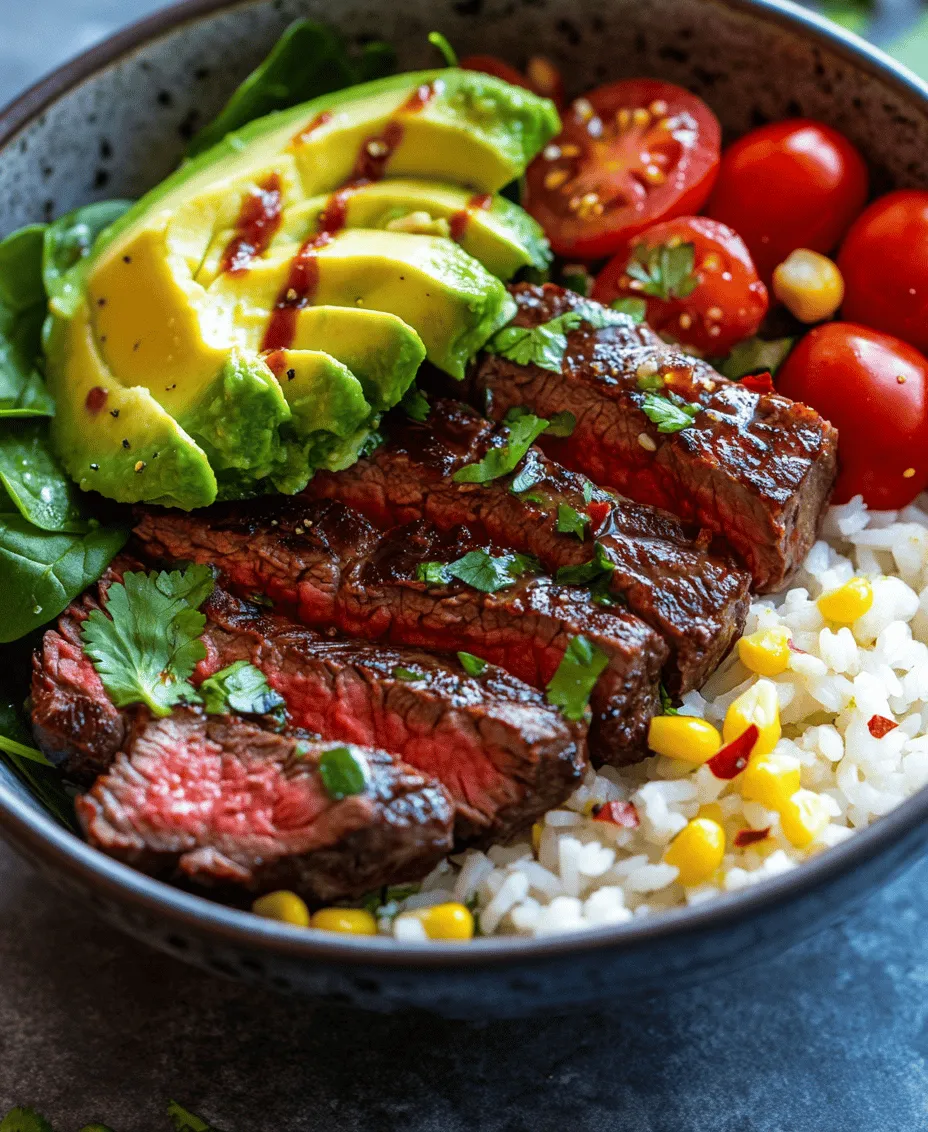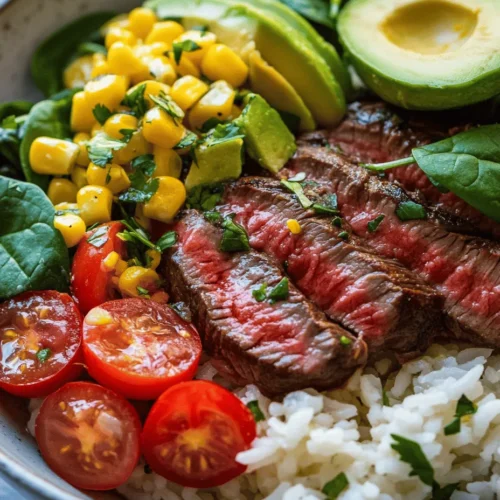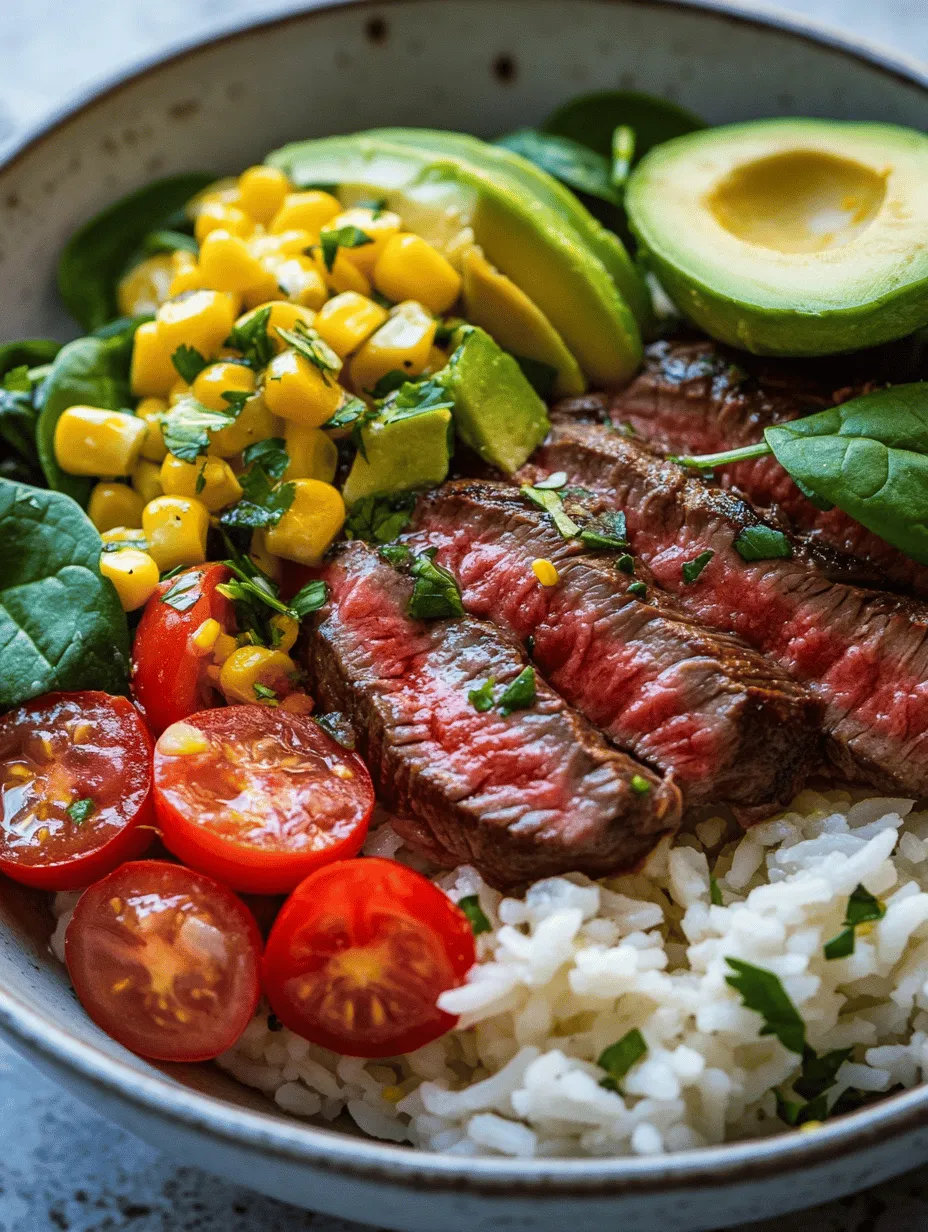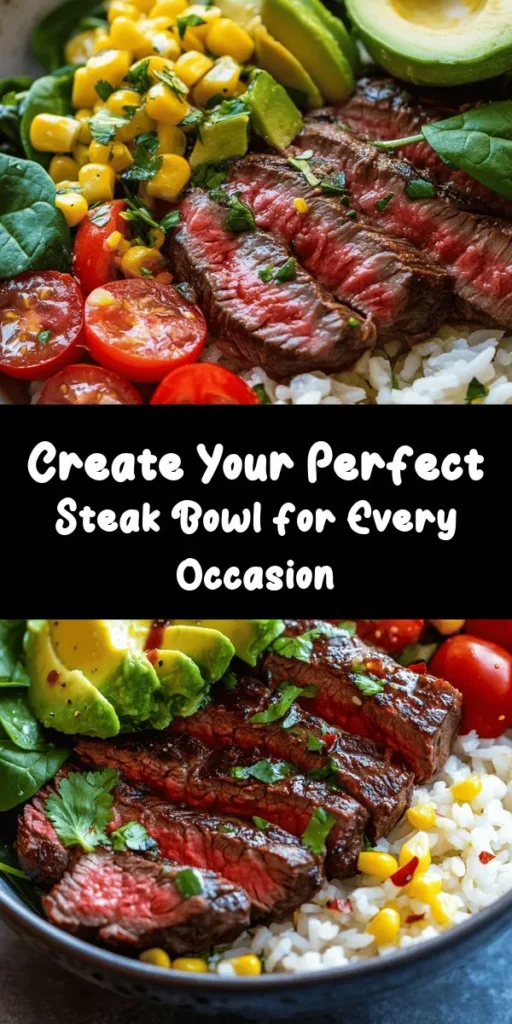Introduction
The steak bowl is a culinary delight that brings together the hearty flavors of perfectly cooked beef, the comforting texture of rice, and the vibrant freshness of vegetables. This dish is not just about satisfying hunger; it’s about creating a balanced meal that caters to all the senses. The combination of protein, carbohydrates, and colorful veggies makes the steak bowl a beautifully arranged plate that appeals to both the eyes and the palate.
In today’s fast-paced world, finding meals that are both nutritious and delicious can be a challenge. The ultimate steak bowl answers that call with its versatility. Whether you’re planning a family dinner, prepping meals for the week, or hosting a gathering with friends, this dish can be easily adapted to suit any occasion. The best part? It’s customizable! You can tweak the ingredients to match individual dietary preferences, making it a crowd-pleaser for everyone around the table.
Understanding the Ingredients
To create the perfect steak bowl, understanding your ingredients is crucial. Each component plays a vital role in the overall flavor, texture, and nutritional value of the dish. Let’s break down the key ingredients that make this dish a standout.
Ribeye Steaks: Flavor and Tenderness
At the heart of the steak bowl is the ribeye steak, renowned for its rich flavor and tenderness. This cut of meat is marbled with fat, which not only enhances its taste but also ensures that it remains juicy when cooked. The ribeye is perfect for this dish because it can be grilled, pan-seared, or broiled, allowing for various cooking methods that suit personal preferences. When choosing ribeye steaks, look for cuts that have a good amount of marbling and a bright red color, indicating freshness.
Jasmine Rice: Texture and Aroma
Complementing the savory steak is jasmine rice, a fragrant grain that pairs beautifully with the robust flavors of beef. Known for its slightly sticky texture, jasmine rice absorbs the juices from the steak and any accompanying sauces, adding an extra layer of flavor to each bite. When prepared correctly, jasmine rice brings a subtle floral aroma and a light, airy texture that elevates the entire dish. If you’re looking for alternatives, consider using brown rice for added fiber or cauliflower rice for a low-carb option.
Fresh Vegetables: Health Benefits and Flavor Enhancement
A well-balanced steak bowl wouldn’t be complete without fresh vegetables. They not only add color and vibrancy but also pack a nutritional punch. Vegetables such as bell peppers, broccoli, and carrots are excellent choices, providing essential vitamins and minerals while balancing the richness of the steak and rice. Incorporating a variety of vegetables not only enhances the flavor profile of the dish but also contributes to a more appealing presentation. Choose seasonal vegetables for the best flavor and freshness.
Spices and Seasonings: Adding Depth to the Dish
Seasoning is where the magic happens in your steak bowl. A well-seasoned ribeye can transform a simple meal into a gourmet experience. Common seasonings include salt, pepper, garlic powder, and paprika, but feel free to experiment with your favorite herbs and spices. Marinades can also be a game-changer, infusing the steak with additional flavor. For those with specific dietary preferences, consider using gluten-free soy sauce or tamari for a tasty marinade without compromising on flavor.
Ingredient Alternatives for Dietary Preferences
One of the greatest advantages of the steak bowl is its adaptability. If you’re cooking for someone with dietary restrictions, there are numerous alternatives you can consider. For instance, if you’re looking to make the dish vegetarian or vegan, replace the ribeye with grilled portobello mushrooms or marinated tofu. You can also substitute jasmine rice with quinoa or farro for a nutty flavor and extra protein. The key is to keep the balance of flavors and textures in mind while accommodating everyone’s preferences.
Preparation Steps Explained
Now that we have a solid understanding of the ingredients, let’s dive into the preparation steps that will guide you in creating the ultimate steak bowl.
Preparing the Rice
The first step in creating your steak bowl is preparing the rice. While it may seem straightforward, the method you choose can significantly impact the final result. For the best flavor, consider using beef broth instead of water when cooking your jasmine rice. This simple swap adds depth and enhances the overall taste of the dish.
To begin, rinse your jasmine rice under cold water until the water runs clear. This process removes excess starch, which can make the rice gummy when cooked. Once rinsed, combine the rice with beef broth in a pot at a ratio of 1:1.5 (1 cup of rice to 1.5 cups of broth). Bring the mixture to a boil, then reduce the heat to low, cover the pot, and let it simmer for about 15 minutes. After the cooking time, remove the pot from heat and let it sit for an additional 10 minutes. This resting period allows the rice to finish cooking and ensures a fluffy texture.
Seasoning the Steaks
While the rice is cooking, it’s time to focus on the ribeye steaks. Proper seasoning is crucial for enhancing the natural flavors of the meat. Start by patting the steaks dry with a paper towel, which helps achieve a nice sear when cooking. Generously season both sides with salt and freshly cracked black pepper. For added flavor, consider a simple garlic and herb rub. A mixture of minced garlic, fresh rosemary, and thyme can elevate the taste profile, making the steak irresistible.
Cooking the Steaks
The method you choose for cooking the ribeye steaks can vary based on your preferences and available equipment. Two popular options are pan-searing and grilling, both of which yield delicious results.
– Pan-Searing: Heat a cast-iron skillet over medium-high heat and add a tablespoon of oil with a high smoke point, such as canola or avocado oil. Once the oil is shimmering, carefully place the seasoned steaks into the pan. For a medium-rare steak, cook for about 4-5 minutes on each side, depending on the thickness. It’s essential to avoid moving the steaks around too much; let them sear to create a beautiful crust. Use a meat thermometer to check the internal temperature, aiming for about 130°F for medium-rare. After cooking, let the steaks rest on a cutting board for at least 5 minutes before slicing. This resting period allows the juices to redistribute, ensuring a moist and flavorful steak.
– Grilling: If you prefer the smoky flavors that come from grilling, preheat your grill to high heat. Again, place the seasoned steaks on the grill, and close the lid to maintain a consistent temperature. Grill for about 4-5 minutes on each side for medium-rare, adjusting the time based on your desired doneness. Let the steaks rest as mentioned earlier before slicing.
Sautéing the Vegetables
While the steaks are resting, it’s time to sauté the vegetables. This step is crucial for enhancing the dish’s colors and nutritional value. Choose a mix of vibrant vegetables such as bell peppers, snap peas, and zucchini for a delightful crunch and burst of flavor. Heat a tablespoon of olive oil in a skillet over medium heat and add the chopped vegetables. Sauté for about 5-7 minutes until they are tender yet still crisp. Season with a pinch of salt and pepper, and consider adding a splash of soy sauce or a sprinkle of sesame seeds for an extra layer of flavor.
With the rice, steaks, and sautéed vegetables ready, you are well on your way to assembling the ultimate steak bowl. The combination of juicy ribeye, fragrant jasmine rice, and colorful vegetables will not only satisfy your hunger but also create a meal that is visually stunning and packed with nutrients. Keep an eye out for the next section, where we’ll explore assembly tips and serving suggestions to elevate your steak bowl experience.

Cooking the perfect steak bowl is not just about selecting high-quality ingredients; it’s also about employing the right cooking techniques that retain nutrients while enhancing flavors. By mastering these techniques and understanding the importance of balance and presentation, you can create a dish that’s not only delicious but visually appealing as well.
Cooking Techniques for Sautéing to Retain Nutrients and Enhance Flavors
When preparing vegetables for your steak bowl, sautéing is a preferred method that maximizes flavor while preserving essential nutrients. Here’s how to do it effectively:
1. Choose the Right Oil: Use oils with high smoke points, such as avocado oil or grapeseed oil. These oils not only enhance flavor but also withstand higher temperatures without breaking down.
2. Preheat the Pan: Ensure your skillet is hot before adding oil. A properly preheated pan allows for quick cooking, which helps retain nutrients that can be lost in prolonged cooking.
3. Add Vegetables in Batches: If you are cooking multiple types of vegetables, add them to the pan in stages. Start with denser vegetables like bell peppers and onions, and add lighter ones like spinach or zucchini later. This ensures that all vegetables are cooked perfectly without becoming mushy.
4. Sauté Quickly: Aim for a quick sauté, around 3-5 minutes, until vegetables are tender-crisp. This technique not only maintains the vibrant colors of your vegetables but also keeps their nutritional value intact.
5. Seasoning Wisely: Season your vegetables with salt and pepper during cooking to enhance their natural flavors. You can also add spices like cumin or paprika for an added depth.
Balancing Flavors of Vegetables with Seasonings
Achieving a harmonious flavor profile in your steak bowl involves balancing the natural sweetness of the vegetables with savory, spicy, and acidic elements. Here are some tips:
– Sweet and Savory: Combine sweet vegetables (like corn or carrots) with savory ones (like mushrooms or onions). This contrast creates depth and interest in each bite.
– Acidity and Freshness: Incorporating fresh herbs like cilantro or basil can brighten the dish. A splash of lime juice or vinegar can also enhance flavors and balance sweetness.
– Spices and Heat: Experiment with spices and heat levels. A pinch of cayenne or a drizzle of hot sauce can elevate the overall flavor, providing a pleasant kick without overpowering the dish.
Assembling the Ultimate Steak Bowl
Creating an aesthetically pleasing steak bowl is as important as the flavors. Here’s a step-by-step guide to layering your bowl:
1. Base Layer: Start with a generous scoop of rice or quinoa at the bottom of the bowl. This acts as a hearty base that will absorb the flavors of the toppings.
2. Steak Placement: Slice your cooked steak against the grain and arrange it artfully over the rice. The way you cut the steak influences both texture and visual appeal.
3. Vegetable Layer: Add your sautéed vegetables next. Arrange them in separate sections to create a colorful mosaic effect. This not only looks appealing but allows diners to choose their preferred flavors easily.
4. Toppings: Sprinkle cheese (like crumbled feta or shredded cheddar), nuts (such as toasted almonds or walnuts), or seeds (like sesame or pumpkin seeds) over the top for added texture and flavor.
5. Garnish: Finish with fresh herbs like cilantro or parsley and a wedge of lime on the side. A drizzle of your chosen sauce can also enhance the look and taste of your bowl.
Importance of Texture and Color in Food Presentation
The visual appeal of your steak bowl plays a significant role in the overall dining experience. Here are some key points to consider:
– Color Variety: Incorporate a rainbow of vegetables to make the bowl visually enticing. Bright greens, vibrant reds, and deep yellows not only look good but also indicate a range of nutrients.
– Textural Contrast: Balance soft and crunchy elements. The creamy avocado pairs excellently with crisp vegetables, while toasted nuts add an unexpected crunch.
– Layering Techniques: Layering ingredients not only enhances presentation but also allows for a varied flavor experience in each bite. Encourage diners to mix their bowls to discover new combinations.
Suggestions for Additional Toppings or Variations
To personalize your ultimate steak bowl further, consider these additional toppings and variations:
– Cheese: Try different types of cheese like goat cheese for creaminess or pepper jack for a spicy kick.
– Nuts and Seeds: Add a handful of toasted pine nuts or sunflower seeds for an extra crunch.
– Sauces: Experiment with various sauces like chimichurri for a fresh herbal flavor, teriyaki for sweetness, or a creamy ranch for richness.
– Vegetarian Options: Substitute steak with grilled tofu or tempeh for a vegetarian twist while maintaining protein levels.
– Grains: Use a base of cauliflower rice for a low-carb alternative or switch to farro for a nutty flavor and chewy texture.
Flavoring and Finishing Touches
Adding subtle finishing touches can elevate your steak bowl to gourmet status. Here’s how:
– Role of Lime Juice and Cilantro: A squeeze of fresh lime juice brightens the dish and adds a zesty freshness. Pair this with chopped cilantro for a burst of flavor that complements the steak and vegetables beautifully.
– Incorporating Heat: If you enjoy heat, consider adding Sriracha or another hot sauce to your steak bowl. A drizzle provides a spicy kick that enhances the savory elements of the dish.
– Dressing Options: Explore different dressings to suit various flavor profiles. A sesame-ginger dressing pairs well with an Asian-inspired bowl, while a yogurt-based dressing can add a creamy, tangy contrast.
Serving Suggestions
The ultimate steak bowl is versatile enough for various occasions. Here are some ideal scenarios for serving:
– Family Dinners: This dish makes for a satisfying and hearty family meal. Set up a steak bowl bar where everyone can customize their own bowls according to their tastes.
– Meal Prep: The steak bowl is perfect for meal prepping. Prepare individual portions in advance for quick lunches or dinners throughout the week.
– Celebrations: For festive occasions, consider adding decorative garnishes or themed toppings. Think of seasonal vegetables or bright sauces that match the holiday spirit.
– Pairing Suggestions: Pair your steak bowl with a glass of red wine like Cabernet Sauvignon for a robust flavor experience. Alternatively, serve with a crisp salad or roasted vegetables to complement the meal.
– Casual or Elegant: Adjust the presentation based on the occasion. For casual dining, use rustic bowls and relaxed table settings. For a more elegant affair, opt for polished dinnerware and thoughtful garnishes.
Nutritional Benefits of the Steak Bowl
The ultimate steak bowl is not only delicious but also packed with nutritional benefits:
– Protein Content: The steak provides a significant amount of protein, essential for muscle growth and repair. Beans add to the protein count, making this a satisfying meal.
– Vitamins and Minerals: Vegetables contribute vital vitamins and minerals. Leafy greens are rich in iron, while bell peppers provide vitamin C, which aids in iron absorption.
– Carbohydrates: The rice or quinoa base offers a source of complex carbohydrates, providing energy for your daily activities.
– Health Benefits: This balanced meal supports a healthy diet by combining essential nutrients from protein, vegetables, and grains. It can help maintain energy levels, support muscle function, and promote overall well-being.
Conclusion
The ultimate steak bowl is a versatile dish that caters to various tastes and preferences. Its combination of flavors, textures, and colors makes it a hit for any occasion, whether it be a cozy family dinner or a festive gathering. Don’t hesitate to explore variations and personal touches in this recipe, as it allows for creativity in the kitchen.
As you embark on creating your steak bowl, remember the joy that comes from sharing meals with loved ones. Celebrate the flavors, nourish your body, and enjoy the process of crafting a delicious dish that everyone will love. Let your culinary journey inspire others to gather around the table and share in the experience of good food and great company.



